All about skirting boards
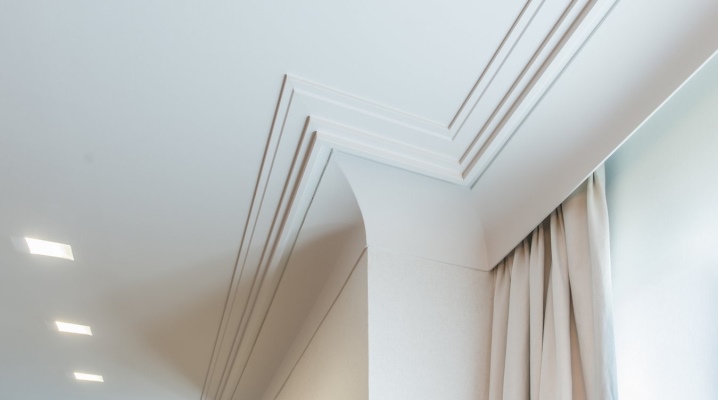
Unfortunately, most people who independently make repairs in their homes lose their strength at the final stages of work, and leave minimal finishing touches "later". This list also includes the installation of a ceiling plinth. However, if you think about it, the installation of masking elements for the corners between the walls and the ceiling is an important stage in creating the beauty of the room, which cannot be postponed.
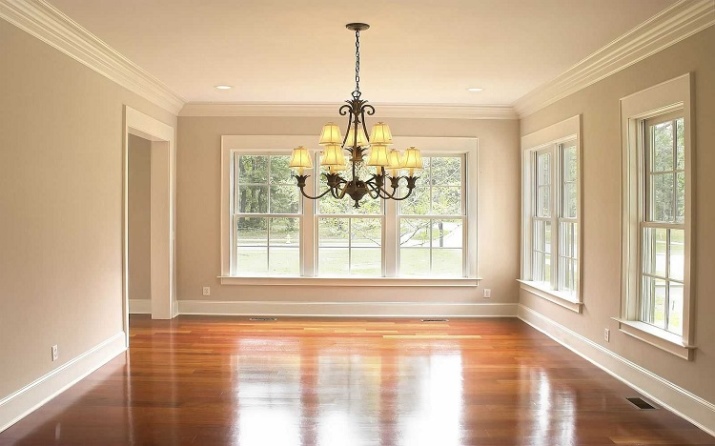
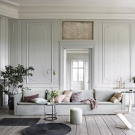
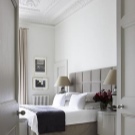
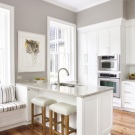
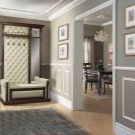
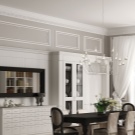
Peculiarities
Not all houses have flat ceilings and walls. And the corners between them leave much to be desired. It is impossible to fix such a defect with your own hands, without knowing the intricacies of pulling surfaces under the level. Fillets are an alternative. Ceiling type skirting boards are not only a decoration of the room. Inside them, you can hide communications, LEDs and much more.
In general, fillets or skirting boards are decorative elements that visually increase the height of the room and expand the space.
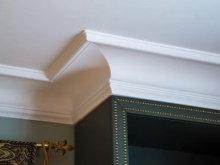
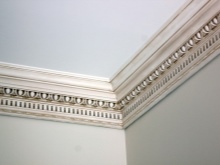
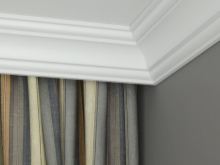
Views
Today there are several types of ceiling plinths, each of which has an impressive number of advantages and some disadvantages.
- Galteli. This type of skirting board is designed to mask ceiling joints and uneven edges of glued wallpaper. Today fillets are on sale in different shapes, sizes and shades. They can have either plastic or wood edging. And the inner void plays the role of a cable channel. They should be installed around the entire perimeter of the room to emphasize the unity of style.
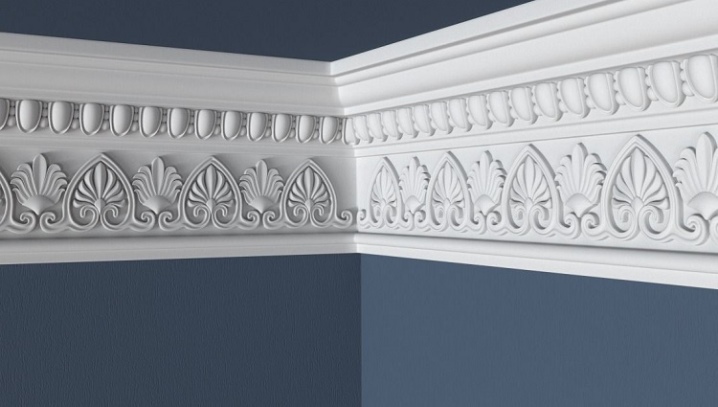
- Molding. This type of ceiling plinth is called a plastic cornice. They can be glued directly to the ceiling or to the joint between the ceiling and the wall. Modern molding models are made of polyurethane, due to which the product is characterized by minimal weight and ease of installation.
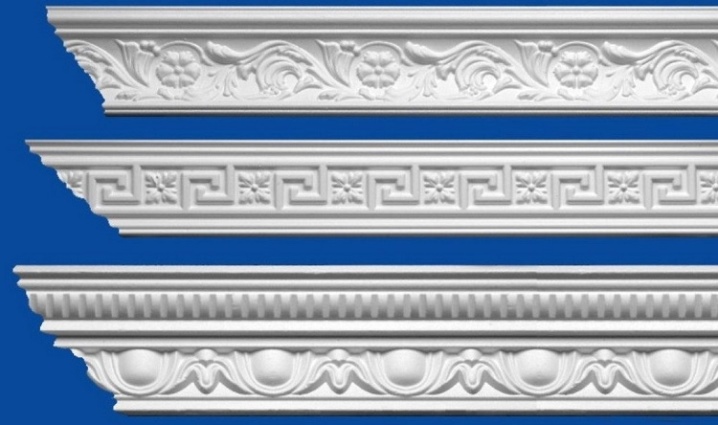
- Baguette. In this case, we are not talking about French bread, but about a decorative strip, shaped like a skirting board with a straight section. A ceiling molding is a plate, the front of which is decorated with an unusual pattern or ornament. The image can be both flat and three-dimensional.
The baguette can be used as a masking of joints and as a frame for a ceiling made of slats.
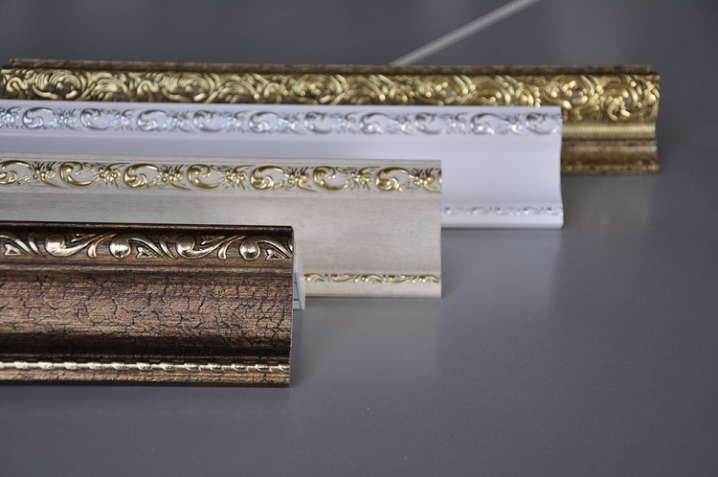
Materials (edit)
In construction supermarkets, there are large departments where various examples of ceiling plinths are presented. Fillets are displayed in the most conspicuous place. They are polystyrene foam, paper, have a flexible structure, but they are fragile.
If you do not want to purchase fillets, you can consider any other analogs of ceiling plinths that are made from more durable materials.
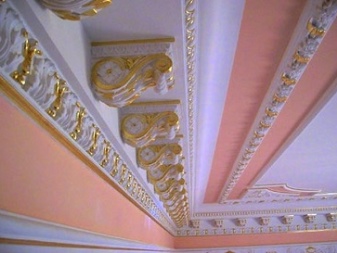
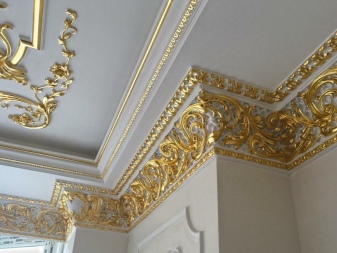
Today ceiling skirting boards are available in a wide variety of designs. You can buy products made of duropolymer, extruded, expanded polystyrene and even with an aluminum profile base. Some are soft, others are shockproof. But the main thing is that each material used has a significant number of advantages.
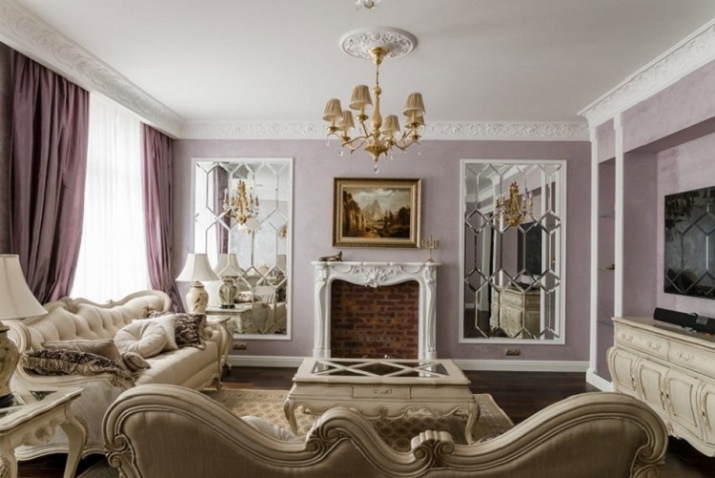
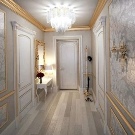
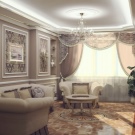

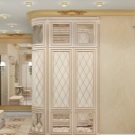
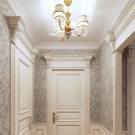
Foam
This material is most often used for the manufacture of ceiling plinths. For the production of foam products, minimum costs are required, hence the low price of the finished product. Foam skirting boards have several important qualities, namely, ease of installation and minimal weight. There is no need to use special construction tools to install it. The only difficulty arises when trimming the product at the required angle.
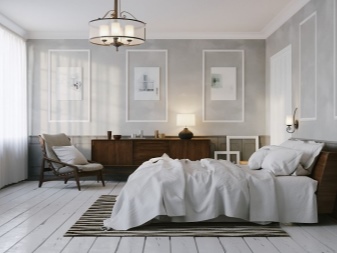
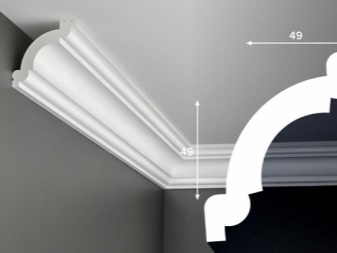
Once the foam skirting board is glued to the ceiling and wall, there is no need to hold it for greater adhesion. And due to the minimum weight, the probability that the product will fall is negligible. The disadvantages of foam plinth include high fire hazard, instability to mechanical stress, as well as the lack of interaction with some adhesives.
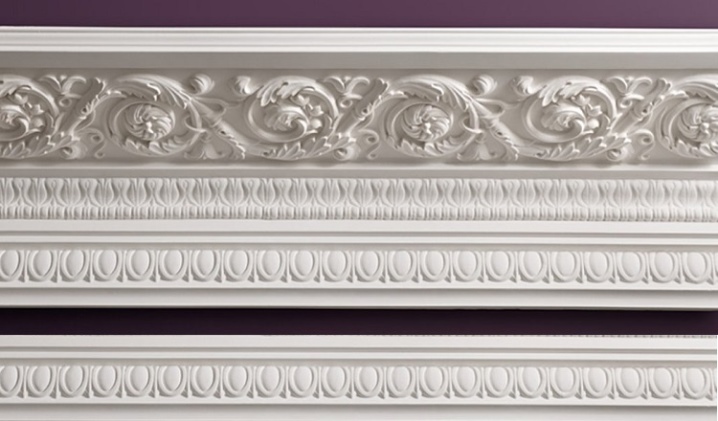
Polystyrene
This material is obtained by polymerizing styrene used as a heat insulator. But due to its decorative properties, polystyrene began to be used in the manufacture of ceiling plinths.
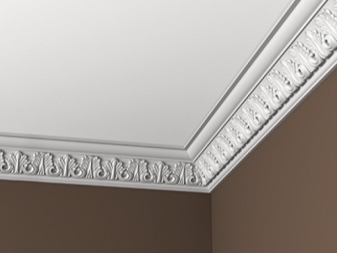
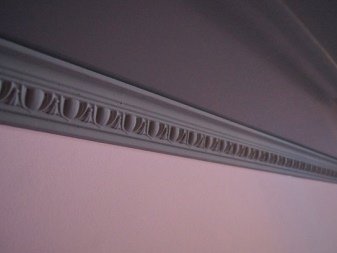
The finished product has many positive aspects:
- a wide variety, thanks to which it is possible to choose a model that corresponds to the general idea;
- the skirting board can be painted in different colors;
- soft edges effectively hide the unevenness of the ceiling and walls, masking defects in the corners.
It should be noted that polystyrene skirting boards can be used to design rounded protrusions, for example, arches. However, when creating curls, special care should be taken, because the fragility of polystyrene has not been canceled.
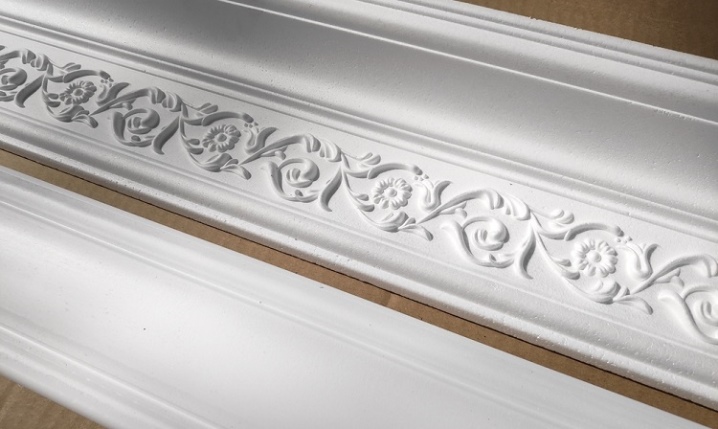
Polyurethane
A modern building material from which many decorative elements are made, including the ceiling plinth. Polyurethane moldings or baguettes have many benefits:
- high level of density;
- clarity of texture;
- variety of designs;
- the ability to design a hidden backlight.
Due to the presence of rubber in the polyurethane skirting board, the products are flexible and acquire bending properties.
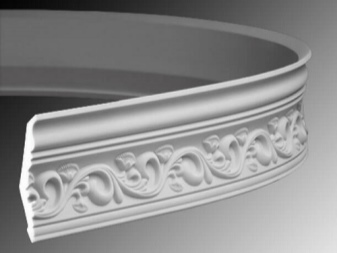
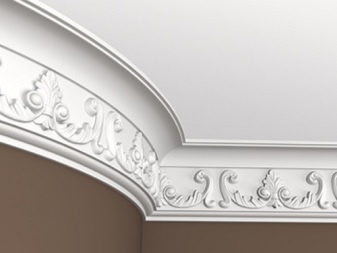
Pvc
The most practical material, similar to the cost of polyurethane skirting boards. But this is the only thing that unites them. In general, the PVC ceiling plinth has several positive characteristics:
- fire safety;
- resistance to mechanical stress and ultraviolet light;
- moisture resistance;
- ease of care.
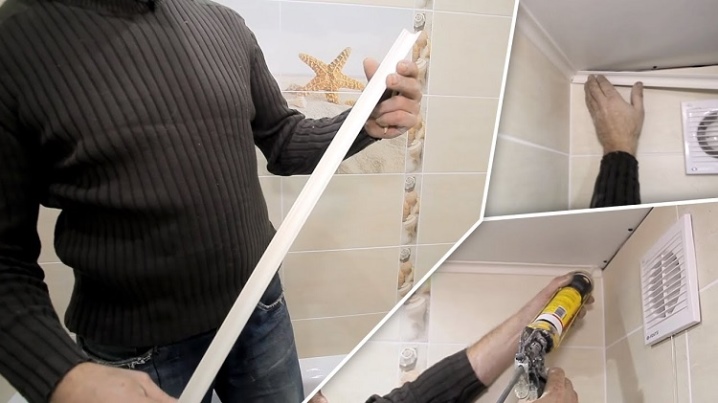
But along with the advantages, there are some disadvantages:
- PVC skirting boards do not have a large width, respectively, it will be difficult to hide the gaps of impressive dimensions;
- products should be mounted only on a flat surface;
- although PVC material is fireproof, it begins to melt when exposed to strong fire.
By the way, there are split skirting boards made of PVC material, where there are fasteners fixed with self-tapping screws. Accordingly, you will not have to spend glue on them.

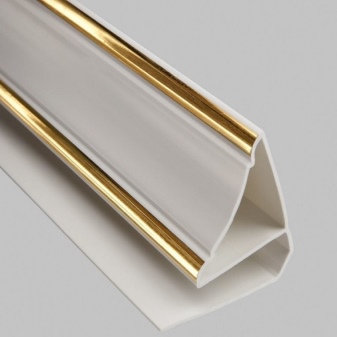
MDF
Today it is almost impossible to find a ceiling plinth made of wood. Basically, such products are made to order, respectively, they cost a lot of money. As a budget analogue in hardware stores, MDF baguettes are presented. Like other samples, they have a number of positive characteristics:
- strength;
- environmental friendliness;
- aesthetics;
- the ability to change the color.
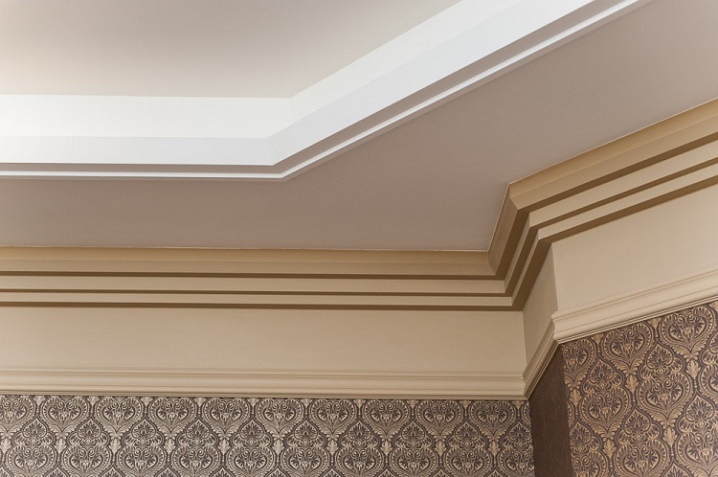
However, along with the positive aspects, there are several unpleasant nuances.
- High price. Unfortunately, not every person is ready to afford to purchase a ceiling plinth, even from a budget pine.
- Regular care. In addition to the fact that the MDF ceiling plinth must be wiped in a timely manner, it is important to ensure that there are no sudden temperature changes in the room, and the humidity remains at a minimum level.
- Complexity of installation. MDF skirting boards must be fastened with screws, dowels or nails. In this case, glue is not an assistant.
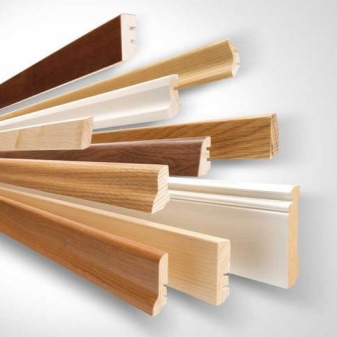

From plaster
Ceiling skirting boards made of plaster are a well-established option, which is in principle common among people who create a particular style in a room. And it is almost impossible to find plaster skirting boards in a store.
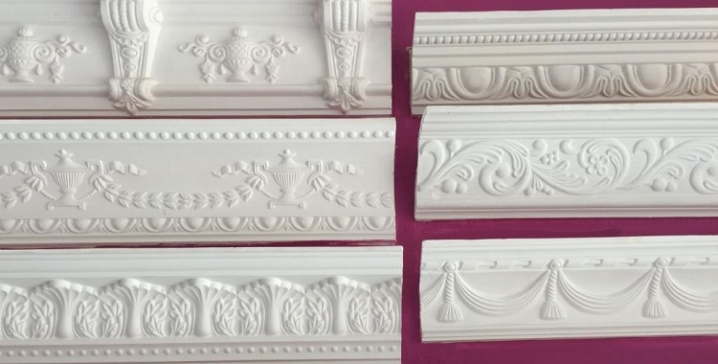
Most of them are made to order. Unfortunately, gypsum products do not have an impressive list of positive characteristics. The only advantages are the ability to emphasize the classic style of the room and finish the design in the Provence style.
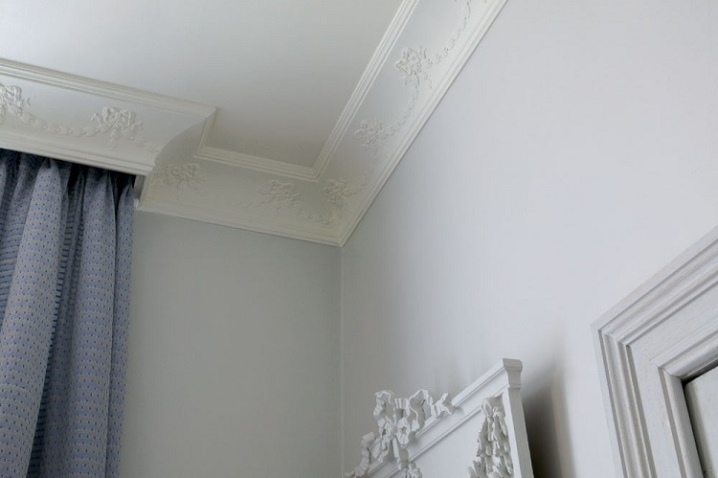
The disadvantages include the following criteria:
- high price;
- fragility;
- complexity of installation.
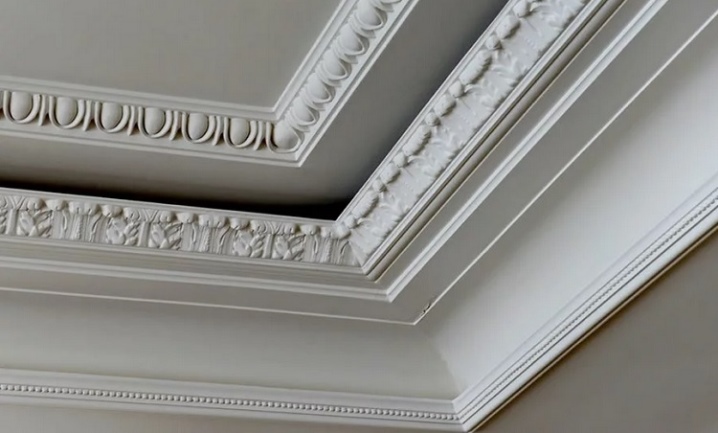
Dimensions (edit)
There is a wide range of skirting boards on the market today, where each individual model has an individual length and width. According to the standard, the fillet length is 2 m, and the width of the product ranges from 1-20 cm. But it is the width indicator that plays an important role when choosing a ceiling molding.
This figure depends on the total height of the room. Wide skirting boards visually smooth out irregularities and hide curved corners. With their help, it is possible to visually increase the length and height of the room.
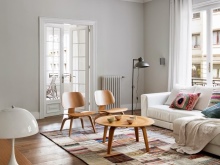
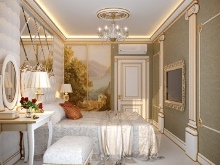
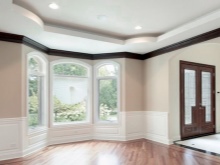
According to the construction requirements, ceiling plinths are divided into several types.
- Narrow. This variety assumes a width of 1-5 cm. It is recommended to use them in rooms with a minimum height.
- Average. In this case, we are talking about a width of 6-15 cm. It is recommended to install such products in rooms with a height of 2.7 m.
- Wide. Their width ranges from 16-35 cm. Such skirting boards adorn the joints of walls and ceilings at a room height of 3 m.
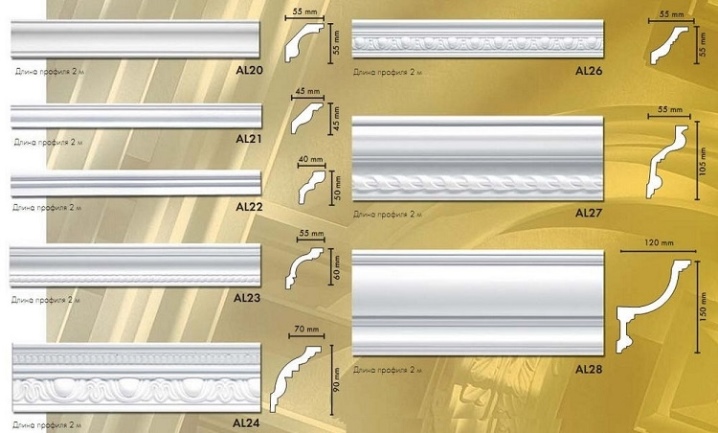
If you choose wide baguettes for a low room, the interior will visually become smaller, and the space will seem narrow. Alternatively, a 100mm option can be considered. Installing thin skirting boards in a tall room will also not work well.
The production length of the ceiling plinths is 1.2, 1.5, 2 m. But this indicator does not play any role, since the fillets have to be cut.

Design
The design of modern fillets cannot be called meager. There are classic products with straight patterns. Instances with a three-dimensional image have been developed. The most incredible baguettes can be made to order, corresponding to a particular style of room decoration. First of all, you need to understand that fillet designs differ in shape.
- Straight. In principle, they can be classified as classics. This is the most popular decor found in home interiors.
- Flexible. These are radius products that can create smooth lines that hide curved corners and ceiling imperfections.
- Hollow. In this case, we are talking about products with an empty interior space where cables or other communications are laid.
Each presented form has a specific direction and functionality. Another important design parameter is the color scheme of the skirting board. Often white items are exhibited in stores, however, there are also colored items with gold and silver frames. But more often people buy white baguettes and paint them in a color that matches the style of the room.
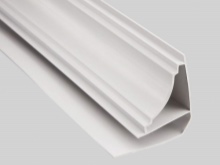
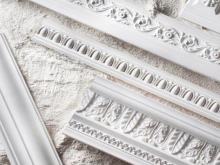
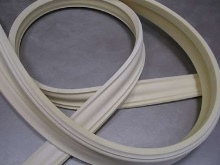
They can be made black, brown, beige, gray, green. It all depends on the general color scheme of the room. To visually expand the space, the baguettes are painted to match the ceiling. To increase the height of the room, it is necessary to paint the baseboards in a shade that matches the walls.
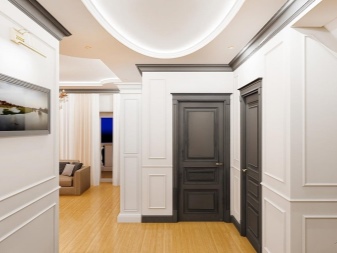
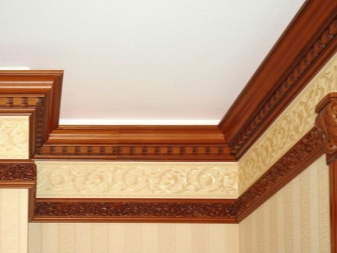
And the last thing that the fillet design depends on is the image used. As mentioned earlier, classic fillets have a pattern of straight lines, although this cannot even be called a pattern. Stucco-type products are more striking. They look expensive and impressive, and bring a sense of luxury to the room. They are ideally combined with classic interiors. Do not forget that the loft style is in fashion now, which is characterized by straightforwardness and flat decorative inserts.
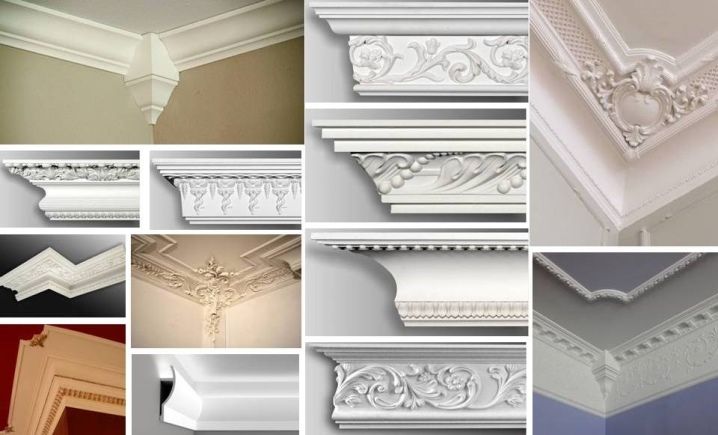
Baguettes with inserts can be white, but most often have a combined color. Convex elements of the picture are painted in gold, silver or dark wenge. The patterned design of the ceiling plinth allows you to revive the ceiling, get rid of its monotony.
Another design option for skirting boards involves the presence of a hollow space inside, where hidden lighting is located. This is a triangular or cube-shaped shape, inside of which there are grooves for attaching the glowing tape. The finished result is so beautiful that the atmosphere in the room is filled with romance.
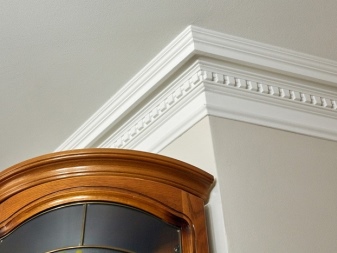

How to choose?
First of all, the choice of a ceiling plinth is influenced by its cost. Next, the width and material from which it is made are studied. However, emphasis should be placed on the weight of the product, density and length. For example, skirting boards made of expanded polystyrene have a high density. But at the same time, their mass is much higher than that of foam baguettes, which are best suited for framing stretch and suspended ceilings.
When choosing a skirting board of the right size, it is important to consider the height of the room. If the distance from floor to ceiling is no more than 2.5 m, you should opt for skirting boards up to 3 cm wide.
Wider baguettes visually reduce the height of the ceilings, making the room flat.
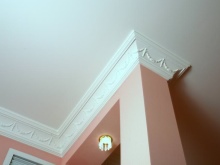
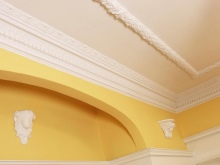
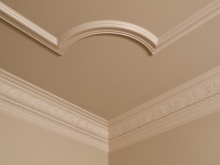
An important factor in the choice is the drawing. On the front side of the skirting boards, straight stripes with a smooth recess can be depicted, which is suitable for a classic style. It is recommended to frame a room in Provence style with products with a patterned image.
Another important selection criterion is the installation method... Some products sit on glue, others are fastened with fasteners with self-tapping screws. When making calculations to calculate the required number of ceiling plinths, it is important to understand that fillets will overlap the joints of the ceiling and walls throughout the entire area. They should be installed under curtains, in places where tall cabinets are located.
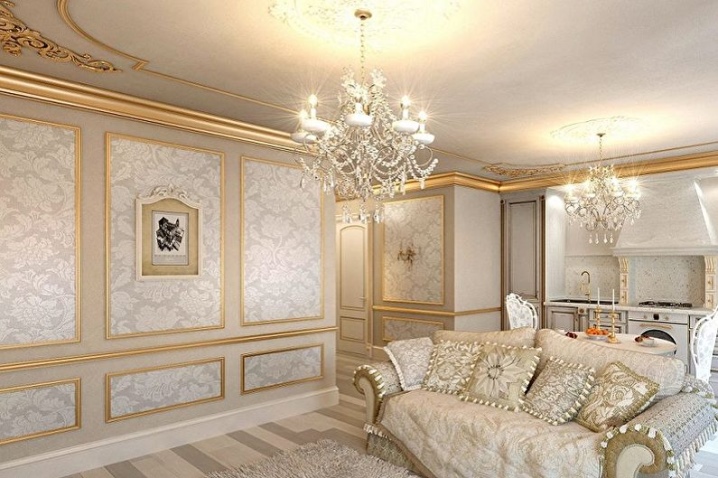
Mounting
Do-it-yourself installation of ceiling plinths is a responsible work, making mistakes is impossible. Even a small flaw can lead to the loss of the effect of the completeness of the repair. To prevent this from happening, you must follow some rules and adhere to the installation sequence:
- markup;
- cutting;
- fastening;
- termination;
- painting.

Those who have at least minimal experience in gluing fillets understand that the only difficulty arises when cutting the corners of skirting boards. From the point of view of the project location, the corners can be internal and external. Accordingly, the cuts on the skirting boards should be 45 degrees. Many types of skirting boards are angled to the ceiling and wall base. This means that it is impossible to make a correct cut on a plane, even with the use of a protractor.

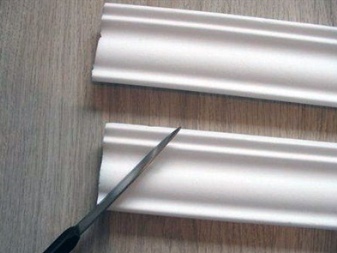
To date, several methods have been developed to create a docking corner. The most effective is cutting with a miter box. This is a tool consisting of 3 U-shaped panels. On opposite sides there are cuts at different angles.
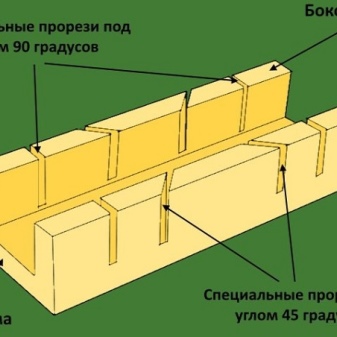

The miter box can be used to cut skirting boards from a wide variety of materials. The main thing is that the cross-sectional connectors allow you to place fillets in themselves. Preferably use a hacksaw or sharp knife for cutting.

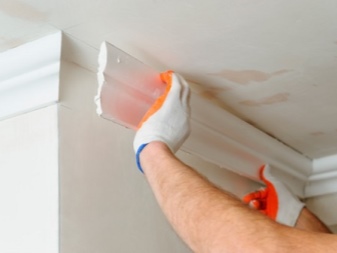
Having dealt with the technical side of the miter box, you can start creating the corner. A plinth is inserted into the section, and a cut is made with a sharp blade at an angle of 45 degrees. Cut off the fragment carefully, but the main thing is not to confuse the direction of the corner.
To eliminate errors, there are template cuts on the walls of the miter box, where marks are made with the designation of the cut being made. Having made a cut of the 1st fillet, you can start framing the 2nd plinth. Further, both cut parts are processed with sandpaper. Then the fitting is done on site.
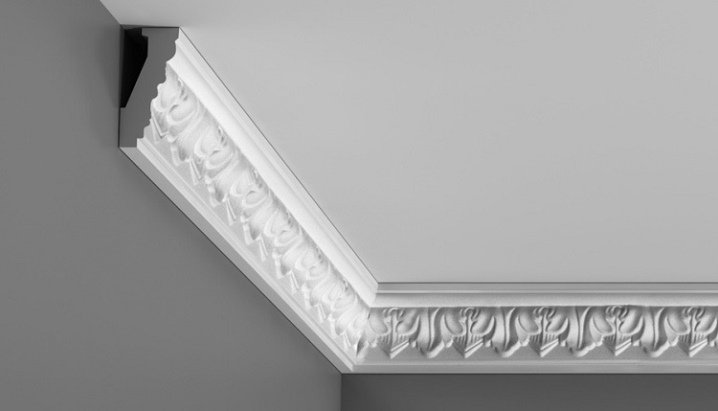
The second way involves using paper. To begin with, an imprint of the ceiling corner is made on a blank sheet, then its bisector is drawn. Next, the sheet is laid out on a flat surface, close to the vertical plane. For this purpose, you can take a wooden box. The plinth is also applied there.The bisector is connected to the markings on the paper, after which the cut is made. You can cut the second skirting board in place. All that remains is to adjust the corners.
Unfortunately, this method of joining cannot boast of being perfect, and the craftsmen have to modify the corners with the help of finishing mixtures.
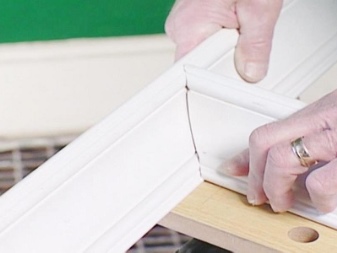

Now you can mount the prepared fillets. Marking is made on the surface of the ceiling and walls, then the first fillet is taken, coated with glue, but not with a continuous layer, but with a partial application of the composition. A transparent sealant can be used as an adhesive. It is not difficult to use it, the main thing is to have a special pistol. Next, the ceiling plinth is applied to the corner according to the markings and pressed slightly. The next plinth must be connected to the first so that there is no gap between them. Thus, the joints of the ceiling and walls are closed.
The next stage of installation requires covering the joints between the skirting boards. Plaster mortar will work to fill the gaps. Once it is dry, the fillets can be painted in the desired color. For arched openings and wavy line joints, a soft skirting board is used that can be bent to shape it. The product is glued with a sealant or adhesive mixture. The only "but" - the glued plinth should be strengthened until the glue is completely dry.
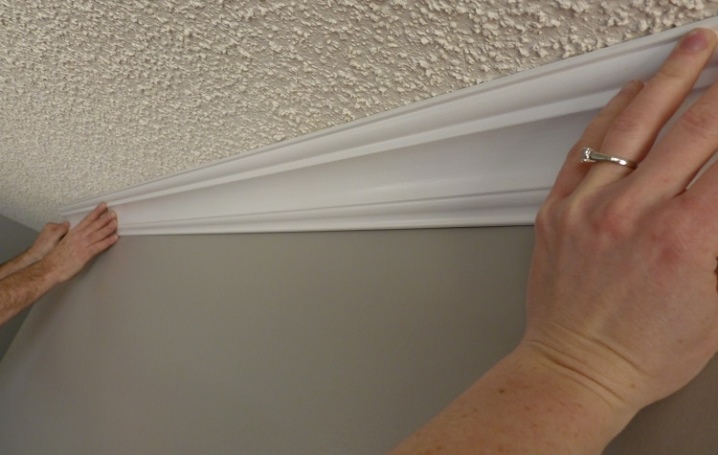
Beautiful examples
The modern person perfectly understands what ceiling plinths look like. In some rooms, such products hide defective corners, in others they are an interior detail, and in others they play the role of decorating additional lighting.
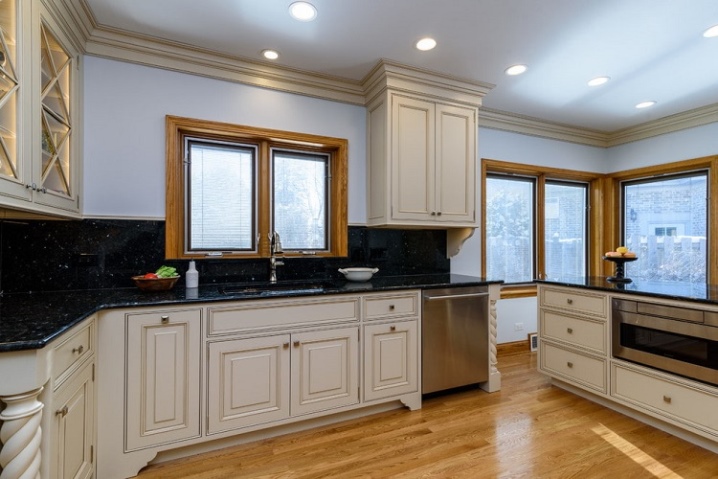
Today, almost all rooms are decorated with ceiling plinths. They are installed in the bedroom, in the living room, in the kitchen, in the hallway and even in the bathroom. Well, the finished premises look as cozy and comfortable as possible.
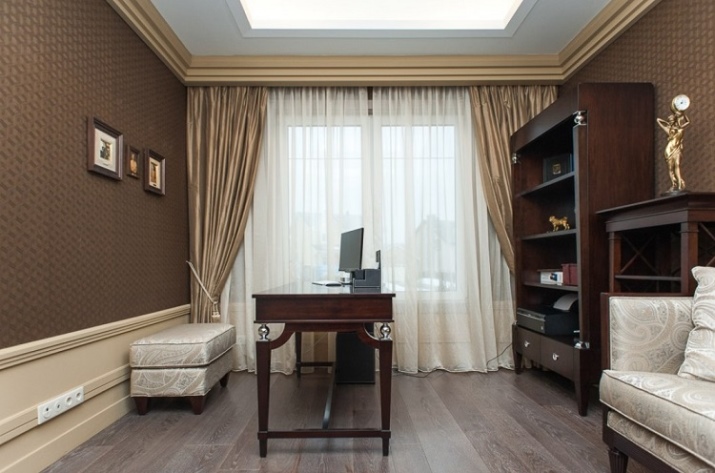
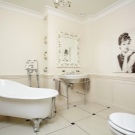
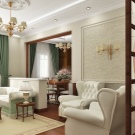
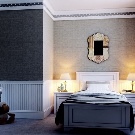
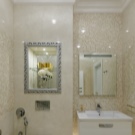

Alternatives
Today, ceiling plinths are widespread. However, those who want to stand out are looking for analogs of fillets that have the same attractive appearance and are combined with the overall interior decoration. Ceiling plinths, moldings, fillets can be replaced with paper panels, cords, thin rope, and a ceramic border. Installation of each proposed option can be done by hand or you can invite a master.
Paper panels are strips with a paper backing. The length of each individual panel does not exceed 1 m, therefore, during installation, new strips must be adjusted to the glued board.
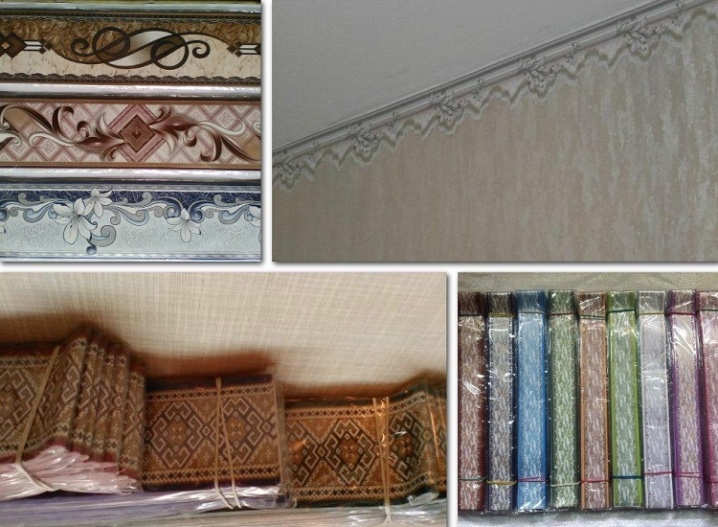
The decorative cord can be purchased at a furniture shop or made by yourself. A braided rope can become its analogue. Most notably, the cords can be used for wall decoration with any material. Even frame the edges of the stretch ceiling.
The ceramic border is a modification of the standard tiles and has a maximum width of 5 cm. Often they are used to separate the wall decoration in the central part. However, the designers revised this material and, once lifting it to the junction of the ceiling and walls, they realized that this is a unique solution to create a beautiful corner.
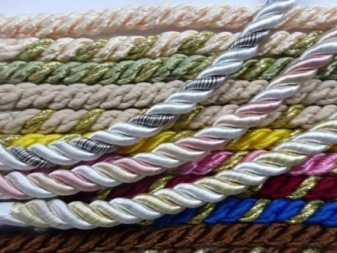
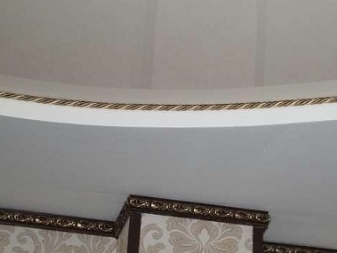
For information on how to glue the ceiling plinth and molding cornice, see the next video.













The comment was sent successfully.